India’s heirloom jewellery carries not just beauty but also history. Each piece reflects centuries of heritage, from Raani Haars and intricate chokers to Nizam-inspired jewels and temple-style ornaments.

These pieces, handcrafted with techniques like jadau, meenakari, and polki, evoke the essence of royal India and are making a vibrant comeback. Preserved by families or meticulously adapted by jewellers, they are treasures of tradition, capturing attention across generations with timeless elegance.
The Sacred Role of Heirlooms in Indian Weddings
Indian weddings are incomplete without jewellery, especially heirlooms passed down from one generation to the next. This practice is a cherished tradition; every inherited piece represents family values, stories, and connection to one’s roots. For brides, the jewellery they wear on their big day holds a depth of significance that goes beyond ornamentation. Among the must-haves are Raani Haars, chokers, bajubands, kamarbandhs, and the mangalsutra—all meticulously crafted by master artisans from the finest materials. Each piece adorns the bride with layers of meaning, representing her family’s legacy and traditions.
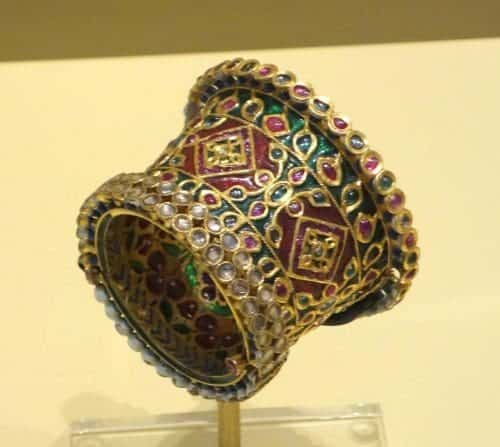
Here are some famous examples of heirloom jewellery in India, each with its own cultural significance and rich history:
Temple Jewellery
Originating in South India, temple jewellery is adorned with motifs of deities, flora, and fauna. Traditionally crafted in gold and studded with rubies, emeralds, and pearls, it was initially created to adorn idols and later adopted by royalty. Famous examples include the Lakshmi Haar, Kemp necklaces, and Kasulaperu (coin necklace), which symbolize wealth and divine blessings.
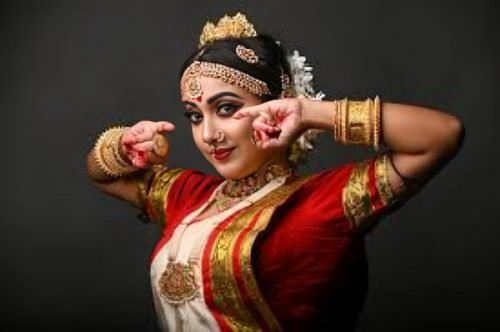
Jhumkas, Chandbalis and Maang Tikka
Jhumkas, traditional bell-shaped earrings, are a quintessential part of Indian heirloom jewellery. Often intricately detailed with meenakari or filigree work, they are adorned with pearls, kundan, or gemstones. Famous examples include Hyderabadi jhumkas, which are often paired with Nizam jewellery.
Chandbalis are crescent-shaped earrings originating from Mughal and Rajput designs. They are often studded with uncut diamonds, pearls, and meenakari enamel. Hyderabadi chandbalis are especially famous, often paired with jadau necklaces for weddings and festivals.
The maang tikka, a forehead ornament, is an integral part of bridal jewellery. Traditional designs often feature uncut diamonds, meenakari work, or pearl embellishments. Examples like the Passa, a side maang tikka, are commonly associated with Mughal and Rajput aesthetics.
Navratna Jewellery
Navratna jewellery features nine gemstones, each representing a celestial body in Hindu astrology. These pieces are considered auspicious and are often passed down as family heirlooms. Examples include Navratna pendants, earrings, and chokers, prized for their symbolic and aesthetic value.
Bajuband (Armlet) and Kamarbandh (Waistband)
Worn by brides and women during traditional ceremonies, bajubands are elaborate armlets crafted in gold or silver with intricate carvings, kundan settings, or embedded gemstones. They hold cultural significance in South and North India, especially in royal Rajput attire.
The kamarbandh, a jewelled waistband, is a statement heirloom piece often worn with sarees or lehengas during weddings. South Indian versions feature intricate temple designs, while North Indian styles are adorned with kundan and polki.
Pacheli Bangles, Hathphool, Nath (Nose Ring) and Padaka Necklace
Pacheli bangles, originating in Rajasthan, are wide cuffs adorned with intricate meenakari and polki work. Often passed down as heirlooms, these bangles are worn during weddings and festive occasions.
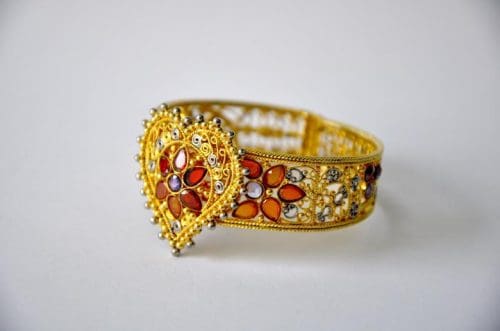
Hathphool, or hand jewellery, consists of a bracelet connected to rings by delicate chains. This piece is a popular heirloom item, particularly in North India, symbolizing grace and femininity.
Traditional naths, or nose rings, are iconic heirloom pieces passed down across generations. Designs vary by region, such as the Maharashtrian nath, which features pearls and gemstones, and the large, gold Punjabi nath.
Originating from Maharashtra, the Padaka necklace features a central pendant with intricate motifs in gold, often set with gemstones. It is a cherished family heirloom, representing the state’s cultural heritage.
Antique Silver Tribal Jewellery and Guttapusalu Necklace
In regions like Gujarat and Rajasthan, silver jewellery such as anklets, torques (neck rings), and belts are common heirlooms. These pieces are often passed down within tribal communities, showcasing unique regional craftsmanship. A hallmark of South Indian tradition, the Guttapusalu necklace is inspired by traditional pearl garlands. It features layers of pearls interspersed with gemstones, symbolizing prosperity and elegance.
Raani Haar: Majestic Elegance Through the Ages
The Raani Haar, a grand multi-layered necklace often worn by brides, epitomizes sophistication and grace. Adorned with uncut diamonds, emeralds, or pearls, it showcases intricate polki and kundan artistry. Creating these pieces is a labor of love, with artisans embedding each stone in layers of gold, sometimes spending months to complete a single necklace. Bollywood stars like Deepika Padukone and Sonam Kapoor have donned Raani Haars in their bridal looks, further popularizing the piece. In modern collections by jewellers like Sabyasachi and Amrapali, the Raani Haar is now made adaptable, with detachable elements that allow wearers to shift from ceremonial grandeur to simpler styles effortlessly.
Embracing Legacy: The Sentiment Behind Heirloom Jewellery
For brides, wearing heirloom jewellery is not just a fashion choice; it’s a cherished moment steeped in nostalgia. Radhika Anant Ambani, for example, left guests mesmerized on her wedding day in a custom Abu Jani Sandeep Khosla lehenga paired with a striking gold and polki set from Roopchand Jewels. Celebrities like Soha Ali Khan, who wore her family’s regal emerald Raani Haar and an antique passa, and Athiya Shetty, who adorned her grandmother’s chandbali earrings for her mehendi, show how these inherited pieces add personal meaning to bridal attire, evoking an aura of history and sentiment that no modern jewellery can replicate.
Nizam Jewels: The Art of Hyderabadi Grandeur
Influenced by the grandeur of the Nizams, Hyderabadi jewels like the Nizam choker and jhumkas are admired for their symmetry and lush detail. Crafted using basra pearls, rose-cut diamonds, and emeralds, these pieces exude a sense of royal finesse. Alia Bhatt is known to favour these intricate chokers, often combining them with contemporary outfits.
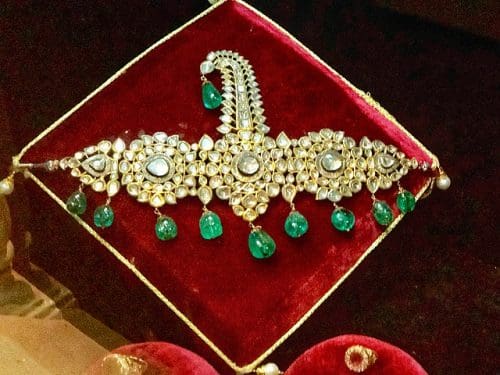
Jewellers like Kishandas & Co. for Sabyasachi have reimagined the Nizam-inspired choker with modern settings that offer traditional grandeur with added comfort, making these pieces adaptable for both ethnic and Western styles.
Bollywood’s Love Affair with Vintage Glamour
Bollywood’s embrace of heirloom jewellery has elevated these vintage pieces to iconic status. From Deepika Padukone’s elaborate wedding look, where she wore an ornate polki choker and Raani Haar, to Priyanka Chopra’s jadau-adorned ensemble, Bollywood brides have become torchbearers of the heirloom revival. Their glamorous appearances set trends, sparking a surge in demand for similar heritage pieces. Actresses like Yami Gautam and Sonam Kapoor have also showcased heirloom pieces that hold personal and familial meaning, making these treasures even more aspirational.
Diamonds: Timeless Radiance in Indian Heirlooms
Indian artisans have long embraced diamonds in intricate designs such as polki, kundan, and jadau, where uncut diamonds, often sourced from historical mines, are crafted into mesmerizing, vintage-style pieces that have captivated generations.
The art of polki, for instance, involves setting raw, unpolished diamonds in layers of gold foil, giving these stones a rustic charm that pairs beautifully with antique designs. This style, often associated with Rajasthani royalty, has been revived by luxury jewellers.
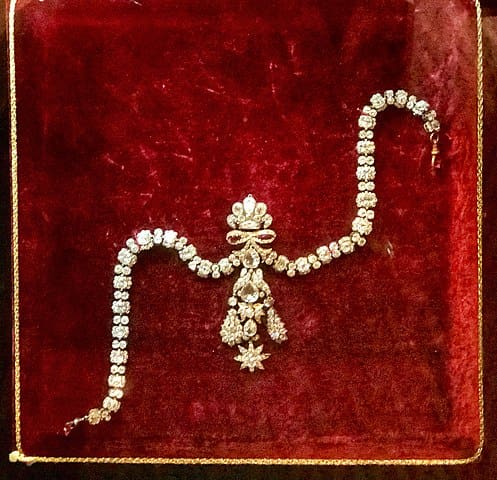
Indian jewellery houses like Tanishq, Hazoorilal Legacy, and Birdhichand Ghanshyamdas Jewellers have redefined the use of diamonds in heirloom-inspired jewellery. This adaptation includes diamond chokers, bangles, and earrings designed for modern tastes, allowing wearers to enjoy the heritage and symbolism of heirloom diamonds in a style that fits both ethnic and Western attire.
Kundan settings, where diamonds are set with enamel in elaborate patterns, showcase skilled craftsmanship that allows each diamond to stand out against a vibrant gold background. This style, popular among Mughal emperors, is now worn by brides and celebrities alike, adding a vintage allure to modern ensembles. Bollywood stars like Priyanka Chopra and Deepika Padukone have been seen wearing kundan necklaces, making these pieces icons of timeless luxury.
Innovative Adaptations by Leading Jewellers
Iconic jewellers such as Sabyasachi, Amrapali, and Manish Malhotra are finding innovative ways to make heirloom designs appealing to today’s aesthetics. For instance, Sabyasachi’s creations often include detachable layers or elements, allowing a single piece to be worn in multiple ways. Amrapali’s polki earrings have been made lightweight without sacrificing vintage allure. Manish Malhotra reimagines the classic Maang Tikka with minimalist, modern designs, infusing a timeless piece with contemporary appeal suitable for varied styles and occasions.
The Emotional Legacy of Heirloom Jewellery
Heirloom jewellery is not just precious; it’s deeply personal. Each piece holds stories, connecting the wearer to her family’s legacy. Restoring heirloom pieces, a delicate process undertaken by skilled artisans, ensures these precious items remain as strong as their sentimental value. Families today are increasingly documenting the history behind their jewellery, preserving not only the pieces themselves but the memories they hold. The rebirth of heirloom jewellery is not just about fashion—it’s about sustaining cultural narratives, beauty, and personal identity for future generations.
Through its revival, heirloom jewellery has transformed from being relics of the past to vibrant expressions of heritage and style, finding new meaning in the hands of today’s wearers. With modern adaptations, celebrity influence, and a renewed appreciation for exquisite craftsmanship, India’s heirloom jewellery has secured its place as an enduring symbol of elegance and tradition.
Renowned jewellery houses associated with heirloom jewellery:
- Hazoorilal Legacy – Known for exquisite kundan and polki pieces, blending heritage with contemporary flair.
- Birdhichand Ghanshyamdas Jewellers – Famous for intricate meenakari work, polki, and Rajasthani-inspired designs.
- Gem Palace, Jaipur – A historic jeweller celebrated for its Mughal-inspired and antique-style collections.
- Motiwala & Sons – Recognized for stunning jadau and diamond heirloom collections.
- Kalyan Jewellers – Known for traditional South Indian gold pieces, including temple jewellery and intricate diamond settings.
- PN Gadgil Jewellers – Popular for traditional Maharashtrian and regal-inspired pieces.
- Narayan Jewellers – Crafting timeless, high-quality heirloom jewellery with a focus on jadau and uncut diamonds.
- Tara Jewellers – Known for unique interpretations of classic heirloom pieces with a contemporary twist.
- Ganjam Jewellers – Specializes in fine, handcrafted South Indian and temple jewellery with a heritage feel.
- Raj Mahtani Couture Jewels – Famed for opulent designs inspired by traditional Indian art and heritage.
Each of these houses has carved a niche in preserving traditional craftsmanship while creating heirloom pieces that continue to enchant collectors and enthusiasts. Heirloom Jewellery is dedicated to preserving India’s rich legacy in jewellery, creating pieces that captivate and connect the past with the present, allowing each generation to hold onto a piece of India’s storied tradition.
Read more: Latest



